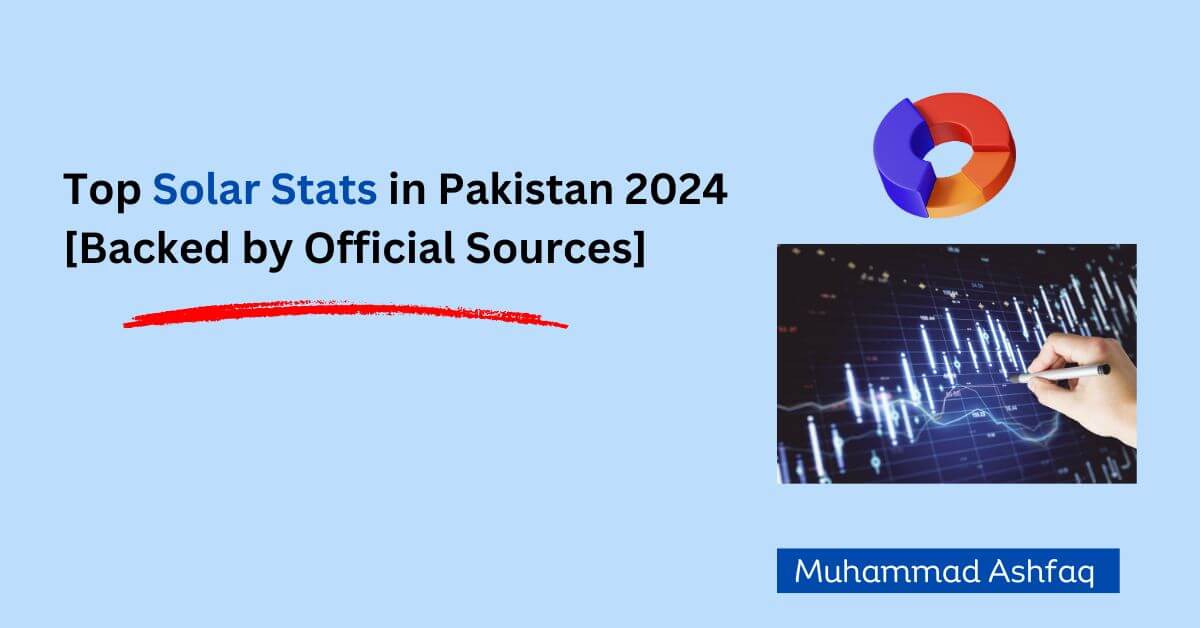Top Solar Energy Stats in Pakistan You Need to Know
Solar energy is rapidly transforming Pakistan’s energy sector.
That’s the reason understanding its growth matters for businesses, policymakers, and researchers.
In this blog, I’ve gathered 17 key solar energy statistics, all derived from credible government reports, official industry publications, and global energy authorities.
Use this resource as a reliable reference to guide your decisions and research while discovering why solar energy is shaping Pakistan’s future.
Installed Solar Capacity in Pakistan
As of 2023, Pakistan’s total installed solar capacity reached 1,244 megawatts (MW)—a remarkable 17% increase since 2021 (IRENA).
Future Projection of Solar
In 2024, Pakistan is expected to add between 10 GW and 15 GW of solar capacity, with major contributions from residential and industrial sectors (BloombergNEF).
Total Solar Imports
In the first half of 2023, Pakistan imported approximately 13 GW of solar modules, ranking as the third-largest destination for Chinese solar exports (BloombergNEF).
Total Solar Investment
Solar panel imports in 2023 were valued at $1 billion, showcasing substantial investment in solar technology (Pakistan Today).
Net-Metering Installations
By mid-2023, Pakistan had 63,703 net-metering solar installations with a total capacity of 1,055.03 MW (Ministry of Energy).
Renewable Energy Targets
The Pakistani government aims for 20% renewable energy by 2025 and 30% by 2030 under its Alternative Energy Policy (Ministry of Energy).
Solar Energy’s Current Share
Solar energy currently accounts for 8.7% of Pakistan’s renewable energy capacity, with significant room for growth (Mordor Intelligence).
Large-Scale Solar Projects
Seven operational utility-scale solar projects contribute a combined 530 MW to the national grid (Ministry of Energy).
Pakistan’s Solar Irradiance Potential
With an average of 7 peak sun hours, Pakistan is an ideal location for solar energy generation (Mordor Intelligence).
Largest Solar Plant Installation (Private Owned)
The 26 MW n-type photovoltaic power plant, completed by Orient Energy Systems and JA Solar, represents a major leap in solar technology deployment (Mordor Intelligence).
Addressing the Energy Deficit by Solar
Pakistan’s energy deficit of approximately 5,000 MW can be significantly reduced through solar power (BloombergNEF).
Solar Capacity Growth Rate
From 2024 to 2029, solar capacity is expected to grow from 1.41 GW to 9.53 GW, reflecting a 46.55% compound annual growth rate (CAGR) (Mordor Intelligence).
Solar’s Contribution to Total Energy
As of 2023, solar accounts for only 1.4% of Pakistan’s total installed energy capacity, indicating massive growth potential (The Nation).
NEPRA’s Solar Forecast
NEPRA projects that photovoltaic capacity will rise to 12.8 GW by 2030 and an impressive 26.9 GW by 2047 (The Nation).
Certified Solar Installers in Pakistan
With over 400 certified solar installers nationwide, Pakistan’s solar workforce is expanding rapidly (The Nation).
Utility-Scale Solar Expansion Plans
The government plans to install 9 GW of solar PV capacity, including 6 GW for utility-scale projects, reflecting a commitment to expanding infrastructure (Mordor Intelligence).
Total Solar Potential
Pakistan has an estimated solar power potential of 40 gigawatts (GW), which could significantly contribute to the country’s energy needs. (Wikipedia)
Why These Stats Matter?
These statistics highlight Pakistan’s progress in solar energy adoption. The rapidly growing solar market presents significant opportunities for businesses, homeowners, and policymakers.
The data not only demonstrates the economic and environmental benefits of solar power but also shows the potential for solar energy in Pakistan.
Conclusion: Pakistan’s Bright Solar Future
With abundant sunlight, supportive government policies, and increasing investments, the country is making remarkable strides in renewable energy.
These stats provide insights into the challenges and opportunities ahead, offering a roadmap for future growth in the solar sector.
FAQs
Pakistan is emerging in solar energy, ranking as the third-largest importer of Chinese solar modules in the first half of 2023.
Reliable information can be sourced from government reports, industry publications, and organizations like AEDB, NEPRA, and international bodies such as IRENA.
Yes, solar energy can help reduce Pakistan’s energy deficit of approximately 5,000 MW by providing clean and reliable power solutions.
The Pakistani government aims to achieve 20% renewable energy in the energy mix by 2025 and 30% by 2030, with solar playing a major role.
As of 2023, Pakistan’s total installed solar capacity is 1,244 MW, reflecting significant growth in both residential and industrial sectors.

Content Writer | Assistant Manager (Electrical) at IESCO
As a passionate content writer, I’m on a mission to make solar hassle-free for you through my expert guides and easy-to-digest content.

